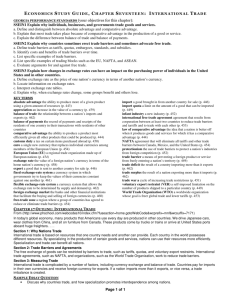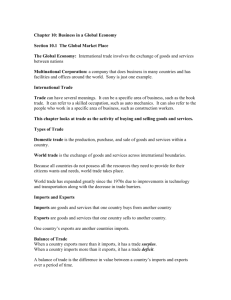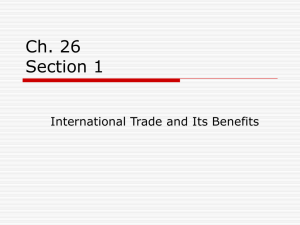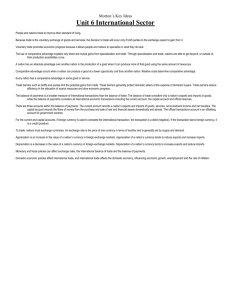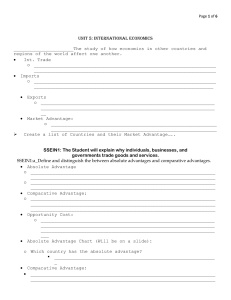GPS - International Economics
advertisement
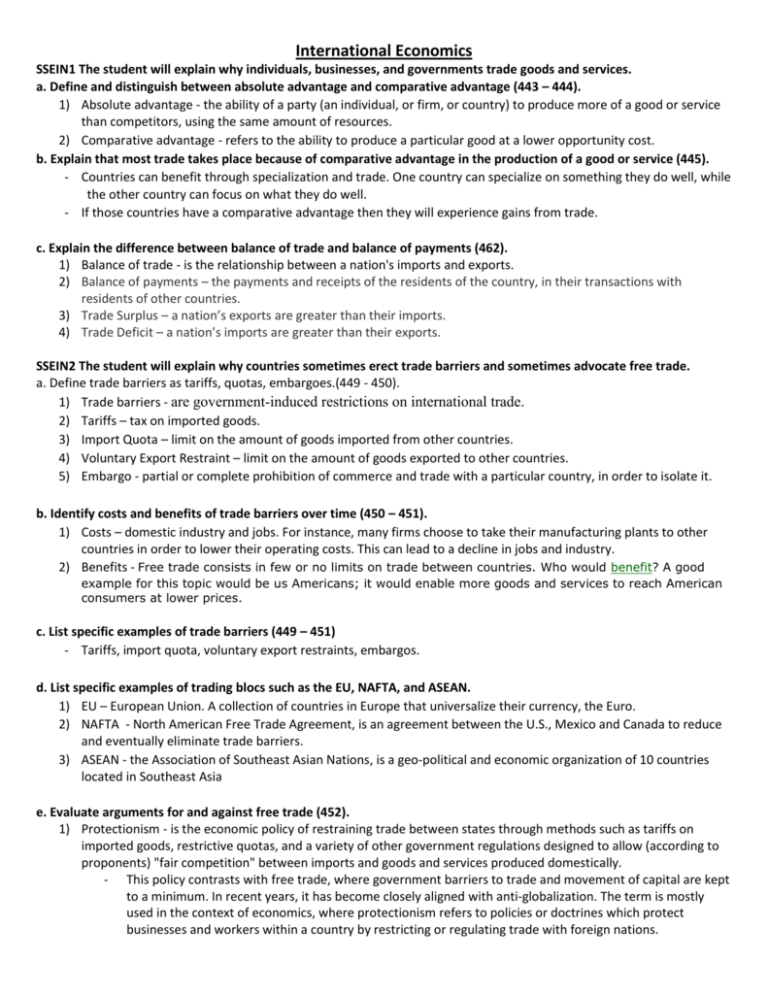
International Economics SSEIN1 The student will explain why individuals, businesses, and governments trade goods and services. a. Define and distinguish between absolute advantage and comparative advantage (443 – 444). 1) Absolute advantage - the ability of a party (an individual, or firm, or country) to produce more of a good or service than competitors, using the same amount of resources. 2) Comparative advantage - refers to the ability to produce a particular good at a lower opportunity cost. b. Explain that most trade takes place because of comparative advantage in the production of a good or service (445). - Countries can benefit through specialization and trade. One country can specialize on something they do well, while the other country can focus on what they do well. - If those countries have a comparative advantage then they will experience gains from trade. c. Explain the difference between balance of trade and balance of payments (462). 1) Balance of trade - is the relationship between a nation's imports and exports. 2) Balance of payments – the payments and receipts of the residents of the country, in their transactions with residents of other countries. 3) Trade Surplus – a nation’s exports are greater than their imports. 4) Trade Deficit – a nation’s imports are greater than their exports. SSEIN2 The student will explain why countries sometimes erect trade barriers and sometimes advocate free trade. a. Define trade barriers as tariffs, quotas, embargoes.(449 - 450). 1) Trade barriers - are government-induced restrictions on international trade. 2) Tariffs – tax on imported goods. 3) Import Quota – limit on the amount of goods imported from other countries. 4) Voluntary Export Restraint – limit on the amount of goods exported to other countries. 5) Embargo - partial or complete prohibition of commerce and trade with a particular country, in order to isolate it. b. Identify costs and benefits of trade barriers over time (450 – 451). 1) Costs – domestic industry and jobs. For instance, many firms choose to take their manufacturing plants to other countries in order to lower their operating costs. This can lead to a decline in jobs and industry. 2) Benefits - Free trade consists in few or no limits on trade between countries. Who would benefit? A good example for this topic would be us Americans; it would enable more goods and services to reach American consumers at lower prices. c. List specific examples of trade barriers (449 – 451) - Tariffs, import quota, voluntary export restraints, embargos. d. List specific examples of trading blocs such as the EU, NAFTA, and ASEAN. 1) EU – European Union. A collection of countries in Europe that universalize their currency, the Euro. 2) NAFTA - North American Free Trade Agreement, is an agreement between the U.S., Mexico and Canada to reduce and eventually eliminate trade barriers. 3) ASEAN - the Association of Southeast Asian Nations, is a geo-political and economic organization of 10 countries located in Southeast Asia e. Evaluate arguments for and against free trade (452). 1) Protectionism - is the economic policy of restraining trade between states through methods such as tariffs on imported goods, restrictive quotas, and a variety of other government regulations designed to allow (according to proponents) "fair competition" between imports and goods and services produced domestically. - This policy contrasts with free trade, where government barriers to trade and movement of capital are kept to a minimum. In recent years, it has become closely aligned with anti-globalization. The term is mostly used in the context of economics, where protectionism refers to policies or doctrines which protect businesses and workers within a country by restricting or regulating trade with foreign nations. SSEIN3 The student will explain how changes in exchange rates can have an impact on the purchasing power of individuals in the United States and in other countries. a. Define exchange rate (458) - is the rate at which one currency will be exchanged for another. It is also regarded as the value of one country’s currency in terms of another currency. b. Locate information on exchange rates (pg. 458 – 459). c. Interpret exchange rate tables (458 – 459). d. Explain why, when exchange rates change, some groups benefit and others lose. 1) Appreciation – the increase in the value of a currency. This increases the purchasing of one currency against another. 2) Depreciation - the decrease in the value of a currency. This decreases the purchasing of one currency against another.

